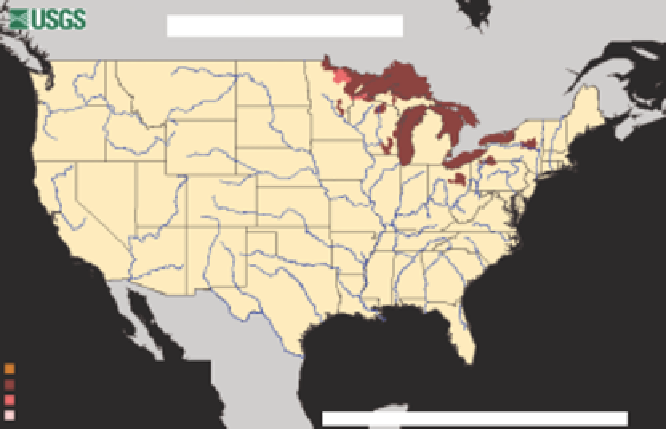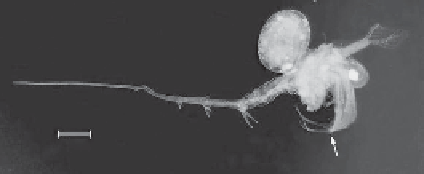Environmental Engineering Reference
In-Depth Information
Bythotrephes longimanus
Map created on 11/8/2011. United States Geological Survey
FIGURE 15.26
U.S. distribution of spiny waterlea. (From Fuller, P., Nico, L., Maynard, E., Larson, J., and
Fusaro, A., USGS Nonindigenous Aquatic Species Database, Gainesville, FL, 2012, Available at http://nas.
er.usgs.gov/queries/factsheet.aspx?SpeciesID = 836 Revision Date: 12/22/2011.)
1.0 mm
FIGURE 15.27
Spiny waterlea. (From USGS; photograph by Kate Feil.)
native species, reduce food supplies for others, and have caused major changes in the zooplankton
community structure of the Great Lakes (USEPA 2008).
15.4.2.2 Zebra Mussels
One of the most notorious of the invasive animal species is the zebra mussel (Figure 15.28). This
freshwater mussel was originally from Asia but it presently occurs in most of Europe. Zebra mus-
sels arrived in the United States in 1986 in the ballast water of a ship and were released into Lake
St. Clair, Michigan (USACE 2001). Since their introduction into the Great Lakes, the mussels have
spread rapidly, partially due to their ability to attach to vessels. They were irst reported west of the
continental divide in 2007, and are rapidly spreading (Figure 15.29).
Many of the problems associated with the relatively small (generally less than 4 cm long) zebra
mussels are their explosive rates of growth and incredible population densities. Their maximum
reported annual production, 29.8 g of dry tissue per square meter per year, is one of the highest
recorded for freshwater or marine bivalves (USACE 2001). Biologists at Detroit Edison reported
that zebra mussel densities on an intake screen climbed from 200 individuals per square meter
(165 individuals per square yard) to 700,000 individuals per square meter (585,284 individuals per
square yard) in 1989. A car submerged for 8 months in Lake Erie was 90% covered with mussels
at an average density of 45,000 individuals per square meter (37,625 individuals per square yard).
As many as 10,000 zebra mussels have been counted on a single freshwater mussel (USACE 2001).


Search WWH ::

Custom Search